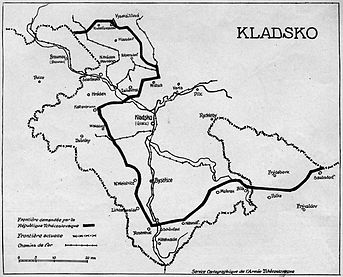County of Kladsko
County of Kladsko | |||||||||
|---|---|---|---|---|---|---|---|---|---|
| 1459–1818 | |||||||||
Poland | 1945 | ||||||||
| |||||||||
| Today part of | Poland | ||||||||
The County of Kladsko (
History
Beginnings
The area has been populated at least since the 1st century BC. The earliest mention of the town itself is in the 12th century Chronica Boëmorum by Cosmas of Prague. He mentions the town of Cladzco as belonging to the Bohemian nobleman Slavník in 981, father of Bishop Adalbert of Prague and progenitor of the Slavník dynasty.
Bohemian–Polish borderland
Held by the
A region of Bohemia
In 1137 by the agency of Emperor
In 1348 the Provincia Glacensis became – still as a region within the Bohemia proper – part of the
In 1458 King
When in 1526 Archduke
In 1617 the first census was organised in the county. The city itself had approximately 1,300 houses and over 7,000 inhabitants. However, two years after the census took place the Thirty Years' War started. Kladsko had joined the Protestant Bohemian Estates and even after the defeat at the Battle of White Mountain in 1620 refused to submit to Emperor Ferdinand II of Habsburg. Between 1619 and 1649 the town was besieged by Imperial troops several times and although the fortress was never captured, over 900 out of 1,300 buildings were destroyed by fire and artillery and the population dropped by more than a half. After the war the Habsburg rulers put an end to all local self-government, and the County existed in name only.
Conquest by Prussia
When in 1740 King
Claim by Czechoslovakia and incorporation into Poland
After
- Proposals by the Czechoslovak Delegation on incorporating Kłodzko Land into Czechoslovakia during the Paris Peace Conference, 1919
-
The maximalist variant
-
The intermediate variant
-
The minimalist variant
Bibliography
- MUSIL, František. Kladsko. Praha : Libri, 2007. 190 s. (Stručná historie států.) ISBN 978-80-7277-340-4.
- A. Herzig, M. Ruchniewicz, Dzieje Ziemi Kłodzkiej, wyd. Dobu Verlag/wyd. Oficyna Wydawnicza Atut, Hamburg/Wrocław 2006.
- Peter Güttler: Das Glatzer Land. Düsseldorf 1995, ISBN 3-928508-03-2
- Ondřej Felcman, Ladislav Hladký, Jaroslav Šůla: Právní postavení Kladska v Českém státě do roku 1742. In: Kladský Sborník 2, 1998, p. 9–33
See also
References
External links
- Grafschaft Glatz
- Map of the County 1747 Archived 2011-07-26 at the Wayback Machine
- Map of the County 1641 Archived 2011-07-26 at the Wayback Machine
- Map of the County 1625 Archived 2011-07-26 at the Wayback Machine
- Tourist site about area
- Státoprávní a národnostní poměry Kladska v historickém vývoji (in Czech)
- Słownik geograficzny Królestwa Polskiego i innych krajów słowiańskich (in Polish)






